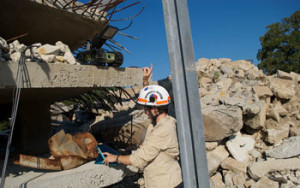
Researcher Robin Murphy studies robot-human interactions, including during disaster scenarios, like this "Disaster Buddy" helper robot. - Credit: Texas A&M University
Research scientist Robin Murphy, who is regarded as a founder of the field of rescue robotics, is working together with Thomas M. Storke, a Professor at Stanford University, in an effort to design a rescue robot with which people feel more comfortable. Their work is being supported by computer software giant Microsoft according to a statement from the National Science Foundation.
In recent years, rescue robots have proved to be a highly valuable asset during natural disasters as they are often the only way to get aid to a trapped victim. But as researchers point out, the robots value is greatly diminished if the victim is scared or annoyed by the interaction with the machine.
“Robots don’t make eye contact. Their tone doesn’t change. When they get closer to people, they start to violate their personal space,” Murphy said. “If you are stuck somewhere for10 hours, and something scares you, or annoys you for long enough, you might start disregarding what it is asking you to do. The term that keeps coming up is ‘creepy.’ People find the robots that are supposed to be helping them creepy.
In an exploration of the social interaction between man and machine, researchers have found that overall people often attach human feelings to computers and intelligent machines with which they directly interact.
“We have one social brain, and it’s the same whether we’re dealing with a person or a machine,” said Clifford I. Nass, the Thomas M. Storke Professor at Stanford University, who studies the social aspects of technology. “People use the same social graces with machines, especially computers, as they do with people.”
With the support of Microsoft, the team is creating a rescue robot which has a multi-media “head” attachment which they call the “survivor buddy”. This user interface is designed to fit on any traditional robot to make the interaction with the victim more socially comfortable. Additional assistance with the interface is coming from an animator from Pixar Studios who will design the motions.
In addition to giving the victim two-way video communication with rescuers and others, the interface can also give the victim the ability to listen to music or watch television to help them pass the time while they wait for rescue. The prototype of the “survivor buddy” was completed over the summer and it awaiting its first real test in an actual disaster.
![Herbal Reference Substances are Key to Everyday Products <!-- AddThis Sharing Buttons above -->
<div class="addthis_toolbox addthis_default_style " addthis:url='http://newstaar.com/herbal-reference-substances-are-key-to-everyday-products/3512112/' >
<a class="addthis_button_facebook_like" fb:like:layout="button_count"></a>
<a class="addthis_button_tweet"></a>
<a class="addthis_button_pinterest_pinit"></a>
<a class="addthis_counter addthis_pill_style"></a>
</div>When it comes to quality control testing and the development of new products, Botanical Reference Materials (BRMs), also known as Herbal References are critically important. To help companies ultimately obtain all-important FDA approval, the Food and Drug Administration provides in its guidance a recommendation that […]<!-- AddThis Sharing Buttons below -->
<div class="addthis_toolbox addthis_default_style addthis_32x32_style" addthis:url='http://newstaar.com/herbal-reference-substances-are-key-to-everyday-products/3512112/' >
<a class="addthis_button_preferred_1"></a>
<a class="addthis_button_preferred_2"></a>
<a class="addthis_button_preferred_3"></a>
<a class="addthis_button_preferred_4"></a>
<a class="addthis_button_compact"></a>
<a class="addthis_counter addthis_bubble_style"></a>
</div>](http://newstaar.com/wp-content/uploads/2021/02/Achillea_millefolium_flowers-100x100.jpg)
![Quality Electrochemical Biosensors are Critical for Medical, Food and Chemical Industry <!-- AddThis Sharing Buttons above -->
<div class="addthis_toolbox addthis_default_style " addthis:url='http://newstaar.com/quality-electrochemical-biosensors-are-critical-for-medical-food-and-chemical-industry/3512086/' >
<a class="addthis_button_facebook_like" fb:like:layout="button_count"></a>
<a class="addthis_button_tweet"></a>
<a class="addthis_button_pinterest_pinit"></a>
<a class="addthis_counter addthis_pill_style"></a>
</div>A number of industries have, at their core, a need to frequent or even continuous analysis of biological media. These include the medical and pharmaceutical fields, biotech firms, and food and chemical companies. To maintain quality standards and develop new products, these industries rely heavily […]<!-- AddThis Sharing Buttons below -->
<div class="addthis_toolbox addthis_default_style addthis_32x32_style" addthis:url='http://newstaar.com/quality-electrochemical-biosensors-are-critical-for-medical-food-and-chemical-industry/3512086/' >
<a class="addthis_button_preferred_1"></a>
<a class="addthis_button_preferred_2"></a>
<a class="addthis_button_preferred_3"></a>
<a class="addthis_button_preferred_4"></a>
<a class="addthis_button_compact"></a>
<a class="addthis_counter addthis_bubble_style"></a>
</div>](http://newstaar.com/wp-content/uploads/2020/10/Electrochemical-Biosensor-100x100.jpg)
![Company Develops Industrial Mixers Well-Suited for both Fragile and Explosive Products <!-- AddThis Sharing Buttons above -->
<div class="addthis_toolbox addthis_default_style " addthis:url='http://newstaar.com/company-develops-industrial-mixers-well-suited-for-both-fragile-and-explosive-products/3512071/' >
<a class="addthis_button_facebook_like" fb:like:layout="button_count"></a>
<a class="addthis_button_tweet"></a>
<a class="addthis_button_pinterest_pinit"></a>
<a class="addthis_counter addthis_pill_style"></a>
</div>Industrial drum mixers are normally applied to blend mixes of varying viscosities such as adhesive slurries or cement. Some of these mixers have the capability of blending mixes of very different particle sizes such as fruit and ice cream, and gravel and cement slurry. The […]<!-- AddThis Sharing Buttons below -->
<div class="addthis_toolbox addthis_default_style addthis_32x32_style" addthis:url='http://newstaar.com/company-develops-industrial-mixers-well-suited-for-both-fragile-and-explosive-products/3512071/' >
<a class="addthis_button_preferred_1"></a>
<a class="addthis_button_preferred_2"></a>
<a class="addthis_button_preferred_3"></a>
<a class="addthis_button_preferred_4"></a>
<a class="addthis_button_compact"></a>
<a class="addthis_counter addthis_bubble_style"></a>
</div>](http://newstaar.com/wp-content/uploads/2020/06/bandeau-sofragir2-100x100.jpg)